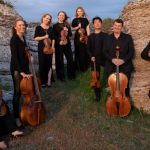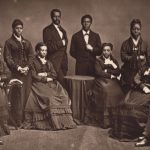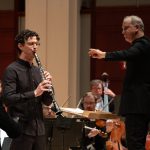October 17, 2025
Emerson Hall, Schwartz Center for Performing Arts
Atlanta, GA – USA
Third Coast Percussion (David Skidmore, Robert Dillon, Peter Martin and Sean Connors, percussion); Salar Nader, tabla (guest).
JLIN: Please Be Still
Jessie MONTGOMERY: Lady Justice / Black Justice, The Song
Tigran HAMASYAN: Sonata for Percussion
Salar NADER: (tabla solo)
Zakir HUSSAIN: Murmurs in Time
William Ford | 20 OCT 2025
The latest program in the Emory University Candler Concert Series, titled Murmurs in Time, was performed by Third Coast Percussion (TCP). The concert took place in the Schwartz Center’s 825-seat Emerson Concert Hall, a space admired for its genial, warm acoustics. On stage stood an impressive array of percussion instruments, each grouping with its own microphone. Two large speaker arrays flanked the stage, with an overhead monitor suspended above. Stay with me—I’ll return to the implications of this setup in a moment, but first, a bit of context.
Percussion ensembles first appeared in the 1930s as avant-garde experiments, became institutionalized by the 1970s, and have since evolved into full-fledged professional chamber groups like TCP—today among the most innovative voices in classical performance. Founded in 2005 by four Northwestern University alumni in Chicago, Third Coast Percussion has earned international recognition, including a Grammy Award for Best Chamber Music/Small Ensemble Performance and several additional nominations, praised for its innovation, precision, and boundary-crossing collaborations.
At the Schwartz Center, TCP employed amplification throughout the performance. This meant the audience heard not only the musicians but also the sonic decisions of whoever engineered the mix. In short: TCP’s musicians plus amplification equal the TCP product. While the ensemble’s skill and technical control were undeniable, the resulting sound often overemphasized the kick drum and rendered higher frequencies piercing and shrill—a persistent issue for me throughout the evening. To be fair, other leading percussion ensembles also use amplification, so TCP is not unusual in this respect.
The members of Third Coast Percussion are David Skidmore, frequently at the drum stand; Robert Dillon, specializing in keyboard percussion; Peter Martin, a versatile multi-percussionist; and Sean Connors, who focuses on nontraditional percussion and electronics. All of the works on the program were commissioned by TCP to celebrate their 20th anniversary, many from composers with whom the ensemble has longstanding relationships.
The concert opened with Please Be Still by Jlin (aka Jerrilynn Patton). The program notes quote the composer describing the piece as a reimagining of Bach’s Mass in B Minor “Kyrie,” transforming Baroque counterpoint into shimmering rhythmic energy. Waves of marimba and vibraphone fragments intertwined with scratches, rattles, and shakers, creating a constantly shifting texture. I did not hear the Bach reference—but no matter. What I did hear was an upbeat, high-energy, ear-friendly work that served as a strong opener. The melodic percussion instruments provided an accessible anchor, though the amplified sound again seemed unbalanced.
Next came Jessie Montgomery’s Lady Justice / Black Justice, The Song. If you haven’t heard, Montgomery’s music is now nearly ubiquitous wherever contemporary classical music is performed. Inspired by Ori Carino’s holographic painting Black Justice, the piece translates visual layers into sound. Pitched and unpitched percussion are “bent” in pitch by water and air, symbolizing justice warped under pressure. Breathing through tubes and dipping metal discs created a world of glissandi and shifting resonance.
Structured in four evolving sections, the work moves from stability to turbulence and back to fragile calm. For me, the final section—again relying heavily on melodic percussion—was the most accessible, a gentle close to what was at times a very turbulent piece. The middle section, a dense and aggressive cacophony of mixed percussion, I found unpleasant—but likely that was the composer’s intent.
The first half concluded with Tigran Hamasyan’s Sonata for Percussion, a three-movement (fast–slow–fast) work fusing Armenian lyricism with complex rhythmic cycles. “Memories from Childhood” recalled innocence through lilting marimba lines veiled in asymmetric rhythms. “Hymn” provided a meditative center, its gentle seven-beat pulse floating in displaced time. The final movement, “23 for TCP,” pulsed with energy, building on a 23-beat cycle that layered jazz, rock, and classical drive. In part because of its familiar structure, this piece felt more comfortable and less overtly aggressive than some of the earlier works.

Salar Nader at Schwartz Center for Performing Arts, October 17, 2025.
(courtesy of SCPA)
After the break, the program resumed with a tabla solo in honor of Ustad Zakir Hussain, performed by guest artist Salar Nader, an Afghan-born tabla virtuoso and longtime protégé of Hussain. The late Ustad Zakir Hussain, who passed away in December 2024, was universally regarded as the world’s leading tabla player—his technical mastery, inventive spirit, and cross-genre collaborations introduced Indian classical percussion to audiences worldwide.
A tabla solo typically unfolds as a journey from slow, spacious exploration to dazzling rhythmic virtuosity, beginning with a peshkar (introductory improvisation) and kaida (theme with variations), increasing in tempo through rela (rapid passages) and tukda or chakradhar (composed cadences). Throughout, the soloist improvises within a repeating rhythmic cycle (tala), building toward a climactic tihai—a phrase repeated three times to land on the cycle’s first beat (sam). For me, this music induced a hypnagogic state, though I also found myself thinking about how naturally one could trace a line between a tabla solo and the minimalist style of Philip Glass.
The program concluded with Zakir Hussain’s Murmurs in Time, the tabla master’s only work for percussion ensemble, uniting Indian rhythmic tradition with Western percussion color. In the first movement, “Recitation,” spoken tabla syllables (bols) were recited by the microphoned TCP musicians. The second, based on a rela Hussain learned from his father, was fiery and conversational—structured as a dialogue between tabla and ensemble. There was palpable camaraderie among the TCP players and Nader, which added an extra layer of authenticity. There is no doubt that cross-cultural collaboration enriches our musical experience, yet I felt somewhat left behind by the bols; they seemed random, like an invented language—which, perhaps, they are—but I could not discern their logic.
It is important to remember that attending a percussion ensemble concert engages every sense. The stage becomes a sculptural landscape of instruments, and the players’ movements—mallet changes, bow strokes, rhythmic gestures—create a kind of visual choreography. Rather than melody and harmony, we hear shifting textures, silences, and layers of color. A percussion ensemble performance is less a concert than a living, rhythmic sculpture in motion.
Finally, TCP took a brief pause during the Sonata for Percussion to repair a marimba. David Skidmore filled the silence with a joke:
“What’s the difference between a large pizza and a drummer? A large pizza can feed a family of four.”
It was a perfect moment of levity—and, I must admit, a great joke. ■
EXTERNAL LINKS:
- Third Coast Percussion: thirdcoastpercussion.com
- Salar Nader: hsalarnader.com
- Schwartz Center for Performing Arts: schwartz.emory.edu

Read more by William Ford.
RECENT POSTS
 Tine Thing Helseth brings fire and finesse to trumpet concertos by Arutiunian, Penderecki, and Weinberg • 24 Oct 2025
Tine Thing Helseth brings fire and finesse to trumpet concertos by Arutiunian, Penderecki, and Weinberg • 24 Oct 2025 Camerata Nordica Octet brings Scandinavian color and classical clarity to Hodgson Hall • 21 Oct 2025
Camerata Nordica Octet brings Scandinavian color and classical clarity to Hodgson Hall • 21 Oct 2025




.png)